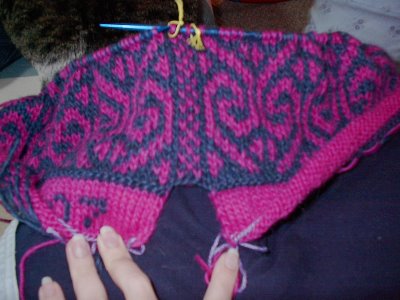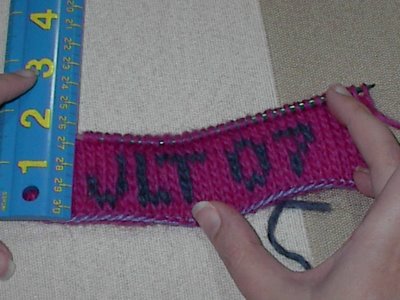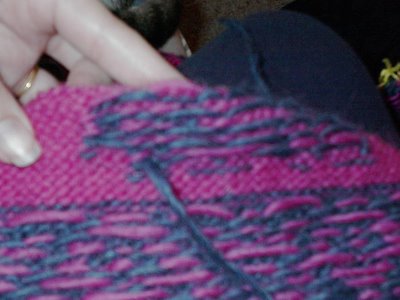
Remember your pattern chart? How there were black squares and white squares in it? From here on out I'm going to refer to 'dark' and 'light' colors. The dark color is whatever you used to knit the black squares on your chart. The light colors are, duh, whatever you used to knit the white squares.
HEM:
Using whatever provisional (or otherwise removeable) cast-on you like, and the light color, USE A NEEDLE TWO SIZES SMALLER THAN WHAT YOU KNIT THE GAUGE SWATCH WITH, and cast on your stitches. Knit BACK AND FORTH, in stockinette, for about 1 3/4 inches, or about 4 cm. The shorter your hem, the higher the odds that it will flip up and look dorky when you wear the sweater. But you don't need a hem up to your arm pits.

Here's mine. Lavender cotton yarn for the cast-on (it was laying around), and pink for the hem. I put in my initials and the year because I always do that when I knit hems. You don't have to. Or you can write anything you want, or put in flowers, or whatever. Since the hem will be folded up and stitched down later, I don't worry about ends; as I go back and forth, I let the dark color dangle until I need it, pick it up and use it, then drop it again. Not the most perfect of techniques, but it works for a couple letters on a hem. Here's the back so you can see what I did:

End your hem on a wrong-side (purl) row. Using the dark color, STILL WORKING FLAT, knit the next three rows. This will give you a purl row that will function as a fold like when you sew down the hem.
JOINING TO KNIT IN THE ROUND:
At this point, make sure your hem is straight and untwisted on the needle. INSTEAD OF TURNING, cast on your steek stitches (if you are using a crochet steek, I suggest five stitches with the backward-loop method), then immediately begin your stranded color pattern. AFTER THE FIRST ROW OF STRANDED COLOR, CHANGE TO YOUR REGULAR NEEDLE. The one you used to knit the gauge swatch with. You will wind up with something that should look like this:

I suggest using stitch markers to mark out the steek and any underarm 'extra' stitches, at least until you've got enough pattern done that you can see what you're doing. I left mine in permanently because I was reading while knitting and stitch markers simplify that.
Knit the rest of the way up the body to the arm pits, ending on the last row of the chart (knit the last row and stop at the steek in the front center).
I'll wait on you guys to decide when I need to post the next steps; let me know when you're at the arm pits, and when I know a couple of you are, I'll start you on the sleeves next.
As always, e-mail me with any questions.













3 comments:
Okay, I need a little help with the whole steek part of the steek-a-long. You mention five stitches in your post if doing the "crochet steek" (I am guessing this refers to using crochet to secure the steek before cutting), but your picture looks like you have a 3 stitch steek. For a person who has NEVER done a steek before and has no idea how she will be cutting it, which is better 5 or 3 stitches? Also, does it matter what pattern I use in the steek area? Any pros or cons to pattern choice? Thanks!
I do, indeed, have a three-stitch steek. I'll be using a crocheted steek and it IS possible to do it over three stitches, but I was afraid I'd freak everyone out with that few steek stitches, and it's best to have a couple extra, so I said five in the directions.
For any type of steek, it's best to knit it as a checkerboard like mine is in the photo. Sorry for not mentioning that.
For details on what kind of steek to use, try "See Eunny knit steeks", linked in my sidebar under knitting links. She covers all types in her little tutorial.
I've tried machine-sewn, crocheted, and raveled-and-knotted steeks, and I prefer the crocheted steek. Partly because they're fast, partly because they're sturdy but stretchy, partly because you can do them over three or five stitches and not waste a lot of yarn, and partly because I don't have to haul the sewing machine out of the closet.
Oh - but if you're knitting with anything other than animal fiber (say acrylic, cotton, or silk) the only steek that works is the machine-sewn steek. And it can get pretty ugly.
Post a Comment